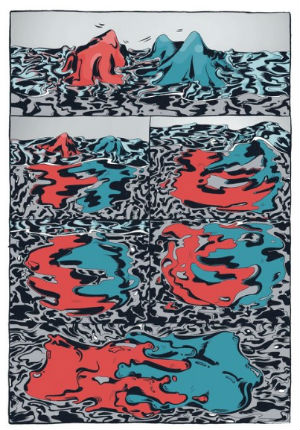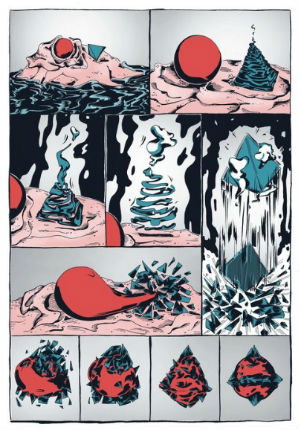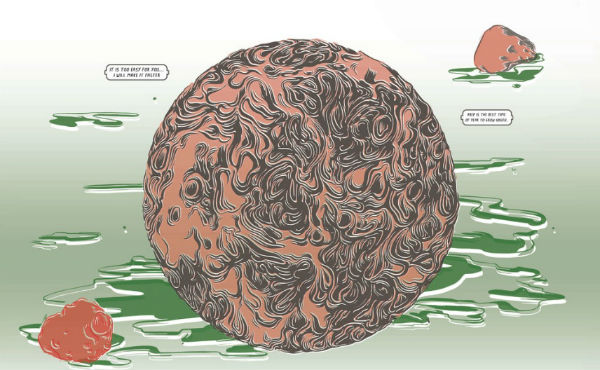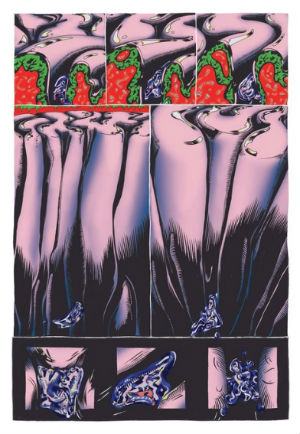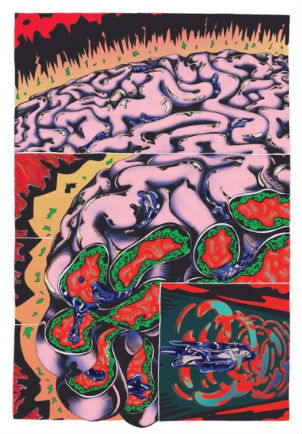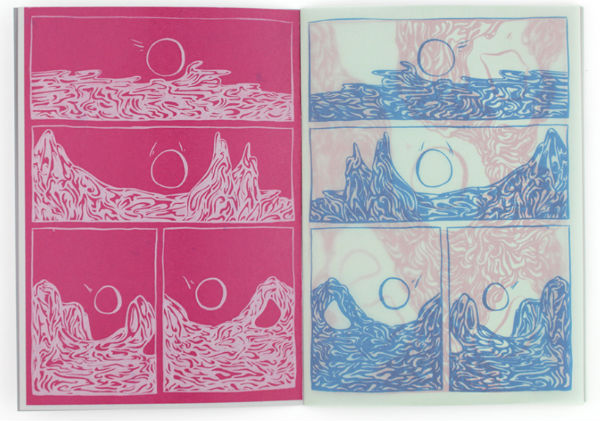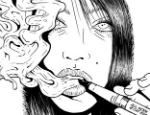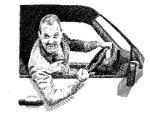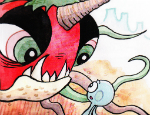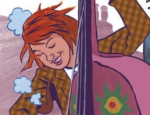ELCAF FORTNIGHT!
Miranda Smart (far left) doesn’t just adopt an intriguingly abstract presentation to her comics, she combines it with a cross-media approach that invites us to think about both the emotional responses the reader has to her practice and also the mechanics of how we interact with her work.
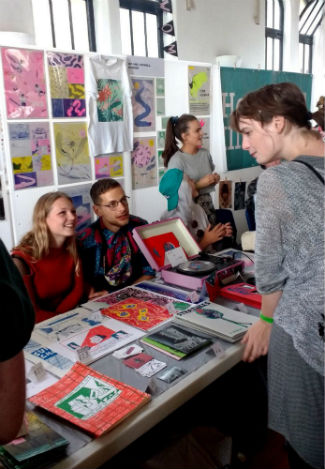 Earlier this year she featured in the abstract issue of venerable sci-fi and fantasy anthology Heavy Metal and longer-term Broken Frontier readers may remember her as a guest artist at one of our Gosh! Comics and Broken Frontier Drink and Draw evenings last year. Ahead of her exhibiting at ELCAF this coming Friday with YAMA Comics I caught up with Miranda to chat about her distinctive approach to comics as a medium…
Earlier this year she featured in the abstract issue of venerable sci-fi and fantasy anthology Heavy Metal and longer-term Broken Frontier readers may remember her as a guest artist at one of our Gosh! Comics and Broken Frontier Drink and Draw evenings last year. Ahead of her exhibiting at ELCAF this coming Friday with YAMA Comics I caught up with Miranda to chat about her distinctive approach to comics as a medium…
ANDY OLIVER: Before we talk specifically about your comics can you tell us a little about your artistic background and wider creative practice?
MIRANDA SMART: I studied Illustration and Visual Media at London College of Communication, where I initially started making comics. I also freelance as an illustrator and do the occasional bit of fine art. I especially enjoy making artwork for bands and being inspired by music but I try not to restrict myself too much and have ended up working on a lot of different types of projects.
AO: How would you describe your comics work in terms of your abstract approach to narrative? What drew you to that more representational area of sequential art?
SMART: I think that’s mostly come about from studying comics theory and trying to understand what the boundaries of cartooning are. I have always felt that people often naturally search for patterns and narratives in any series of images, even abstract ones, and from that I found it an interesting challenge to kind of prove or test how much of this instinct could be played on to create narrative. A sort of, how simple can I make this and still get the picture across, kind of mission. And so in my work I always want people to feel like the narrative has been shaped a lot by their own subconscious or ability to decode patterns from what is on the page.
Images and sound go together in GOBI
AO: Your work also has a cross-media element. Can you talk a little about how you’ve used an accompanying soundtrack to enhance and emphasise the themes of your comics or to visualise sound on the page? In terms of constructing your narratives how does that process work?
SMART: The idea to have an accompanying soundtrack seemed to come quite naturally from what I was saying about simplifying narratives, as I think that a lot of great pieces of music do this same thing. With our collaboration we mostly wanted to mirror each passage of music with its visual accompaniment to create a synergy that would be natural enough for you to know exactly when to turn the page as the music is playing. Drawing sound is another one of those challenges that I find is done very interestingly and diversely in comics and I really just wanted to experiment with the connection between the two mediums. There is always a lot of back and forth with the sound designer, Jope Sound, throughout both creative processes and they are very much intertwined with each other so it’s hard to explain the exact process. With Briz de Mar it started with the outline of the story and the panel splits and then there was some discussions and then as the music progressed some of the story changed to fit with the sound and then it kept developing from there.
AO: What fascinates me about your multi-sensory comics (GOBI, Neighbourhood Wash and Briz De Mar) is the way in which they invite the reader not just to interact with the page on a very personal level but also to experience them on a very instinctual one as well. Would you say that your comics exist as much to evoke an empathetic emotional response as they do to be interpreted directly as individual narratives?
SMART: Yes definitely. I think, especially with Briz de Mar, what I wanted to achieve was the audience to feel surprised by the emotional effect of abstract shapes. Briz de Mar is also based on a very personal story so I guess I didn’t think too much about it whilst I was making it and very naturally drew in shapes and textures how I was feeling about each part, I think maybe that is what makes this one particularly emotional as well. I am however always very aware of how colours and shapes can be really emotional and how powerful our interpretations of certain shapes can be to the way a story makes us feel.
AO: You’ve also worked on a more traditional form of sequential art on the Strainees comic with Jules Moscovici. What’s the premise of the comic and do you have plans to revisit that world?
SMART: Strainees was both our first comic, so it was very free and experimental. The story follows a civilisation on Mars who have contracted a mental health pandemic which effects them in that they can no longer make any decisions. This first book is mostly just a fun look at what that society might look like and an introduction to our main characters, a parent and child called O-lan and Red. We both definitely plan to continue the story in a few more books but are still searching for the time to work on it, however I’m sure that part 2 will appear in the not too distant future.
AO: You recently featured in the abstract comics issue of venerable sci-fi/fantasy anthology Heavy Metal. How did that involvement come about?
SMART: This actually happened very randomly through working in a health food cafe of all places. A girl I worked with knew one of the owners of Heavy Metal, Jeff Krelitz, and he came into the cafe a few times and we started talking comics, he liked my work so eventually put me through to an editor, to who I pitched the idea for ‘Hydroglyphs to Mania’ (below).
AO: Can you tell us a little about your creative process? What mediums do you work in?
SMART: I try to do as much as I can by hand, so I always start with pencils and then trace over with inks, mostly a variety of pens and brush pens. I then scan everything in and colour digitally on photoshop.
AO: You’re exhibiting as part of the YAMA Comics collective at ELCAF. Who makes up YAMA and how did you become involved with the group?
SMART: YAMA comics is a no-pressure collective that I made up for the purpose of doing fairs/exhibitions, it’s very new at the moment so there’s not much I can say about it. I am very lucky to be surrounded by talented artists and friends and it is nice to have an open collective that anyone can be a part of if they chose to. This year at ELCAF it will be myself, Omar Hernandez and Dylan Hall.
Images from Neighbourhood Wash (above) and soundtrack (below)
AO: What can attendees pick up from you this year at ELCAF? What comics, zines and other material will you have on the YAMA table?
SMART: I will have with me; the last few copies of Strainees that I found in a box under a pile of books, also the audiovisual collaboration Briz de Mar, with the vinyl also available to listen to at the stall, a few Wizine zines and some brand new posters/single page comics.
AO: And finally what other projects are you working on at the moment? Are there any other comics we can expect from you in 2019?
SMART: Yess for sure! I’m pretty excited about a new personal project, an audiovisual collaborative comic which I’ve started working on. It has the working title SORE and will be an abstract horror comic with a soundtrack as well.
Miranda Smart will be exhibiting at ELCAF as part of YAMA Comics on Friday June 7th. Visit her site and store here and follow her on Instagram and Twitter.
For more on ELCAF 2019 visit the festival site here and follow them on Twitter here.






